Analysis of Coupled and Coordinated Development of Cultivated Land Multifunction and Agricultural Mechanization in China
Abstract
1. Introduction
2. Materials and Methods
2.1. Study Area Overview
2.2. Data Sources
2.3. Research Methods
2.3.1. Coupling Coordination Analysis Method
2.3.2. Coupled Coordination Mechanism
2.3.3. Spatial Autocorrelation Analysis
2.3.4. Quadratic Assignment Procedure (QAP)
3. Results
3.1. Temporal and Spatial Changes in CLM Utilization and AM Development
3.2. CLM and AM Development Coupling Coordination Analysis
3.2.1. Overall Changes in Coupling Coordination Degree
3.2.2. Spatial Effects of Coupling Coordination Degree
3.3. Analysis of Driving Mechanisms of Coupling Coordination Degree
3.3.1. Internal Driving Factors
3.3.2. External Driving Factors
4. Discussion
4.1. Formation Mechanism of Regional Differences
4.1.1. Regional Differences in Cultivated Land Multifunction Levels
4.1.2. Regional Differences in Agricultural Mechanization Development Levels
4.1.3. Spatial Heterogeneity of Coupling Coordination
4.1.4. Analysis of Driving Factors for Intra-Regional Differences
4.2. Policy Recommendations for Regional Agricultural Development
4.3. Research Limitations and Prospects
- (1)
- Large research scale. Focusing on China’s provincial-level CLM utilization and AM coupling coordination development provides a macroscopic policy-making basis but has limited guiding significance due to the large scale. Moreover, provinces exhibit significant differences in socio-economic development levels, agricultural types, geographical conditions, and policy environments, and provincial-scale analysis might fail to reveal specific local problems or potential opportunities.
- (2)
- Data accuracy and timeliness. Socio-economic data primarily originated from annual statistical yearbooks, comprehensively reflecting provinces’ indicator developments. However, annual statistical data’s timeliness and regional granularity might affect analysis results, especially regarding subtle policy changes and short-term economic fluctuations. Remote sensing data, mainly used for ecological indicator calculations, provide objective spatial information for CLM utilization’s ecological dimensions but might also affect analysis precision through timeliness and spatial resolution limitations.
- (3)
- Model limitations. This study employed entropy weight TOPSIS and coupling coordination models for evaluation system construction. While effective for comprehensive evaluation and coupling relationship analysis, these methods’ inherent assumptions and simplifications might lead to insufficient consideration of some influencing factors. For instance, coupling coordination models often assume linear relationships between factors, but actual relationships between AM and CL ecological functions might be non-linear and intricately interconnected.
5. Conclusions
- (1)
- Development Trends and Imbalance: From 2011 to 2021, China’s CLM levels and AM development indices both showed upward trends, with coupling coordination development levels also improving. However, regional imbalances persist, particularly with AM development differences gradually expanding. Western regions’ CLM levels are significantly lower than other regions, primarily influenced by natural conditions.
- (2)
- Driving Factors: Eastern regions’ agricultural modernization critically depends on technological factors; central regions are influenced by production efficiency and social security differences; western regions’ coordination differences mainly stem from ecological function vulnerability. Therefore, western regions need to develop AM according to local conditions.
- (3)
- Natural Condition Impacts: Natural conditions such as CL area, quality, and land flatness significantly impact coordinated development of AM and CLM. Additionally, rural cooperative numbers, as a manifestation of institutional innovation, to some extent promote agricultural development, emphasizing the complexity of regional agricultural development.
- (1)
- Eastern Regions: Continuously promote AM technological innovation and optimize technology promotion and application to enhance CLM levels.
- (2)
- Central Regions: Optimize production functions and social security systems, promote mechanization development through policy guidance and financial support, and achieve coordinated improvement of CLM and AM.
- (3)
- Western Regions: Strengthen ecological function protection and restoration, enhance agricultural production capacity, and overcome challenges in agricultural modernization processes.
Author Contributions
Funding
Data Availability Statement
Conflicts of Interest
References
- Gu, G.; Shi, L.; Wen, Q.; Niu, S. Coupling and coordination of the multifunction and value of arable land at the regional scale from the perspective of rural hollowing governance. Prog. Geogr. 2024, 43, 587–602. [Google Scholar] [CrossRef]
- Song, X.; Ouyang, Z. Route of Multifunctional Cultivated Land Management in China. J. Nat. Resour. 2012, 27, 540–551. [Google Scholar] [CrossRef]
- Wei, X.; Lin, L.; Luo, P.; Wang, S.; Yang, J.; Guan, J. Spatiotemporal pattern and driving force analysis of multi-functional coupling coordinated development of cultivated land. Trans. Chin. Soc. Agric. Eng. (Trans. CSAE) 2022, 38, 260–269. [Google Scholar] [CrossRef]
- Liu, C.; Xu, Y.; Sun, P.; Liu, J. Progress and prospects of multi-functionality of land use research. Prog. Geogr. 2016, 35, 1087–1099. [Google Scholar] [CrossRef]
- Xiang, J.; Liao, X.; Song, X.; Xiong, J.; Ma, W.; Huang, J. Regional convergence of cultivated land multifunctions in China. Resour. Sci. 2019, 41, 1959–1971. [Google Scholar] [CrossRef]
- Kremen, C.; Merenlender, A.M. Landscapes that work for biodiversity and people. Science 2018, 362, eaau6020. [Google Scholar] [CrossRef]
- Li, C.; Wang, X.; Ji, Z.; Li, L.; Guan, X. Optimizing the use of cultivated land in China’s main grain-producing areas from the dual perspective of ecological security and leading-function zoning. Int. J. Environ. Res. Public Health 2022, 19, 13630. [Google Scholar] [CrossRef]
- Liu, Z.; Xin, Z.; Guo, C.; Zhao, Y. An Analysis Method of System Coupling and Spatio-Temporal Evolution of County New Urbanization and Logistics Industry. Systems 2024, 12, 185. [Google Scholar] [CrossRef]
- Yu, Y.; Lin, J.; Zhou, P.; Zheng, S.; Li, Z. Cultivated Land Input Behavior of Different Types of Rural Households and Its Impact on Cultivated Land-Use Efficiency: A Case Study of the Yimeng Mountain Area, China. Int. J. Environ. Res. Public Health 2022, 19, 14870. [Google Scholar] [CrossRef]
- Chen, C.H. A novel multi-criteria decision-making model for building material supplier selection based on entropy-AHP weighted TOPSIS. Entropy 2020, 22, 259. [Google Scholar] [CrossRef]
- Liang, X.; Jin, X.; Ren, J.; Gu, Z.; Zhou, Y. A research framework of land use transition in Suzhou City coupled with land use structure and landscape multifunctionality. Sci. Total Environ. 2020, 737, 139932. [Google Scholar] [CrossRef] [PubMed]
- Yang, D.; Liu, Z.; Zhang, P.; Chen, Z.; Chang, Y.; Wang, Q.; Zhang, X.; Lu, R.; Li, M.; Xing, G.; et al. Understanding Relationships between Cultivated Land Pressure and Economic Development Level across Spatiotemporal Characteristics: Implications for Supporting Land-Use Management Decisions. Int. J. Environ. Res. Public Health 2022, 19, 16362. [Google Scholar] [CrossRef] [PubMed]
- Gurr, G.M.; Lu, Z.; Zheng, X.; Xu, H.; Zhu, P.; Chen, G.; Yao, X.; Cheng, J.; Zhu, Z.; Catindig, J.L.; et al. Multi-country evidence that crop diversification promotes ecological intensification of agriculture. Nat. Plants 2016, 2, 1–4. [Google Scholar] [CrossRef] [PubMed]
- Montoya, D.; Gaba, S.; De Mazancourt, C.; Bretagnolle, V.; Loreau, M. Reconciling biodiversity conservation, food production and farmers’ demand in agricultural landscapes. Ecol. Model. 2020, 416, 108889. [Google Scholar] [CrossRef]
- Ke, X. Regarding new thoughts on cultivated land protection and utilization. China Land 2023, 9, 28–31. [Google Scholar] [CrossRef]
- Luo, X.; Liao, J.; Hu l Zang, Y.; Zhou, Z. Improving agricultural mechanization level to promote agricultural sustainable development. Trans. Chin. Soc. Agric. Eng. (Trans. CSAE) 2016, 32, 1–11. [Google Scholar] [CrossRef]
- Yang, M.; Bai, R.; Liu, M.; Tu, Z. Development of Agricultural Mechanization and Construction of Modern Agriculture. Trans. Chin. Soc. Agric. Mach. 2005, 36, 68–72. [Google Scholar]
- Wang, B.; Ma, X.; Wang, F.; Chen, Z.; Lin, B. Integration of agricultural machinery and agronomy promoting high-quality and efficient development of agricultural mechanization. Agric. Eng. 2024, 14, 5–9. [Google Scholar]
- Cao, N.; Zhang, J. Empirical analysis on the contribution rate of agricultural mechanization to farmers′ income increase in China. J. Chin. Agric. Mech. 2024, 45, 327–332. [Google Scholar]
- Yan, F.; Sun, X.; Chen, S.; Dai, G. Does agricultural mechanization improve agricultural environmental efficiency? Front. Environ. Sci. 2024, 11, 1344903. [Google Scholar] [CrossRef]
- Zalidis, G.; Stamatiadis, S.; Takavakoglou, V.; Eskridge, K.; Misopolinos, N. Impacts of agricultural practices on soil and water quality in the Mediter-ranean region and proposed assessment methodology. Agric. Ecosyst. Environ. 2002, 88, 137–146. [Google Scholar] [CrossRef]
- Fan, Y.; Jin, X.; Gan, L.; Jessup, L.; Pijanowski, B.; Yang, X.; Xiang, X.; Zhou, Y. Spatial identification and dynamic analysis of land use functions reveals distinct zones of multiple functions in eastern China. Sci. Total Environ. 2018, 642, 33–44. [Google Scholar] [CrossRef] [PubMed]
- Zou, L.; Liu, Y.; Yang, J.; Yang, S.; Wang, Y.; Zhi, C.; Hu, X. Quantitative identification and spatial analysis of land use ecological-production-living functions in rural areas on China’s southeast coast. Habitat Int. 2020, 100, 102182. [Google Scholar] [CrossRef]
- Xue, M.; Wang, H.; Wei, Y.; Ma, C.; Yin, Y. Spatial Characteristics of Land Use Multifunctionality and Their Trade-Off/Synergy in Urumqi, China: Implication for Land Space Zoning Management. Sustainability 2022, 14, 9285. [Google Scholar] [CrossRef]
- Zhou, D.; Xu, J.; Lin, Z. Conflict or coordination? Assessing land use multi-functionalization using production-living-ecology analysis. Sci. Total Environ. 2017, 577, 136–147. [Google Scholar] [CrossRef]
- Qu, Y.; Jiang, G.; Zhao, Q.; Ma, W.; Zhang, R.; Yang, Y. Geographic identification, spatial differentiation, and formation mechanism of multifunction of rural settlements: A case study of 804 typical villages in Shandong Province, China. J. Clean. Prod. 2017, 166, 1202–1215. [Google Scholar] [CrossRef]
- Willemen, L.; Verburg, P.H.; Hein, L.; van Mensvoort, M.E. Spatial characterization of landscape functions. Landsc. Urban Plan. 2008, 88, 34–43. [Google Scholar] [CrossRef]
- Khaled, R.; Hammas, L. Technological Innovation and the Agricultural Sustainability. Environ. Agric. Inform. 2016, 7, 1–14. [Google Scholar] [CrossRef]
- Yin, S.; Wang, Y.; Xu, J. Developing a Conceptual Partner Matching Framework for Digital Green Innovation of Agricultural High-End Equipment Manufacturing System Toward Agriculture 5.0: A Novel Niche Field Model Combined With Fuzzy VIKOR. Front. Psychol. 2022, 13, 924109. [Google Scholar] [CrossRef]
- Devkota, R.; Pant, L.; Gartaula, H.; Patel, K.; Gauchan, D.; Hambly-Odame, H.; Thapa, B.; Raizada, M. Responsible Agricultural Mechanization Innovation for the Sustainable Development of Nepal’s Hillside Farming System. Sustainability 2020, 12, 374. [Google Scholar] [CrossRef]
- Ganguly, K.; Gulati, A.; Von Braun, J. Innovations Spearheading the Next Transformations in India’s Agriculture; ERN: Innovation (Topic); International Food Policy Research Institute (IFPRI): Washington, DC, USA, 2017. [Google Scholar] [CrossRef]
- Harahap, B.; Widodo, W.; Sutanto, A.; Sapar; Syafruddin. The effect of the agricultural mechanization assistance model on socio-economic changes of farmer groups in Palopo city, Indonesia. Int. J. Sci. Res. Manag. 2024, 12, 497–505. [Google Scholar] [CrossRef]
- Zhang, M.; Fang, K.; Zhang, D.; Zeng, D. Relationship between the evaluation of agricultural scientific and technological innovation capacity and the influencing factors of green agriculture. PLoS ONE 2023, 18, e0295281. [Google Scholar] [CrossRef] [PubMed]
- Niu, P.; Zhou, J.; Yang, Y.; Xia, Y. Evolution and Trade-Off in the Multifunctional Cultivated Land System in Henan Province, China: From the Perspective of the Social-Ecological System. Front. Ecol. Evol. 2022, 10, 822807. [Google Scholar] [CrossRef]
- Yu, M.; Yang, Y.; Chen, F.; Zhu, F.; Qu, J.; Zhang, S. Response of agricultural multifunctionality to farmland loss under rapidly urbanizing processes in Yangtze River Delta, China. Sci. Total Environ. 2019, 666, 1–11. [Google Scholar] [CrossRef]
- Ding, B.; Zhao, Y.; Deng, J. Calculation, Decoupling Effects and Driving Factors of Carbon Emission From Planting Industry in China. Chin. J. Agric. Resour. Reg. Plan. 2022, 43, 1–11. [Google Scholar]
- Yang, J.; Huang, X. The 30 m Annual Land Cover Dataset and Its Dynamics in China from 1990 to 2019. Earth Syst. Sci. Data 2021, 13, 3907–3925. [Google Scholar] [CrossRef]
- Geng, Y.; Zhu, H.; Zhu, R. Coupling Coordination between Cultural Heritage Protection and Tourism Development: The Case of China. Sustainability 2022, 14, 15421. [Google Scholar] [CrossRef]
- Deng, Z.; Xiao, Q.; Wang, J.; Li, L. Spatiotemporal characteristics and driving mechanism of the coupling coordination between digital economy and green development in China. Acta Geogr. Sin. 2024, 79, 971–990. [Google Scholar] [CrossRef]
- Xing, L.; Xue, M.; Hu, M. Dynamic simulation and assessment of the coupling coordination degree of the economy–resource–environment system: Case of Wuhan City in China. J. Environ. Manag. 2019, 230, 474–487. [Google Scholar] [CrossRef]
- Geng, Y.; Geng, Y.; Huang, F.; Huang, F. Coupling coordination between higher education and environmental governance: Evidence of western China. PLoS ONE 2022, 17, e0271994. [Google Scholar] [CrossRef]
- Frei, B.; Queiroz, C.; Chaplin-Kramer, B.; Andersson, E.; Renard, D.; Rhemtulla, J.M.; Bennett, E.M. A brighter future: Complementary goals of diversity and multifunctionality to build resilient agricultural landscapes. Glob. Food Secur. 2020, 26, 100407. [Google Scholar] [CrossRef]
- Huang, J.; Tichit, M.; Poulot, M.; Darly, S.; Li, S.; Petit, C.; Aubry, C. Comparative review of multifunctionality and ecosystem services in sustainable agriculture. J. Environ. Manag. 2015, 149, 138–147. [Google Scholar] [CrossRef] [PubMed]
- Wittwer, R.A.; Bender, S.F.; Hartman, K.; Hydbom, S.; Lima, R.A.A.; Loaiza, V.; Nemecek, T.; Oehl, F.; Olsson, P.A.; Petchey, O.; et al. Organic and conservation agriculture promote ecosystem multifunctionality. Sci. Adv. 2021, 7, eabg6995. [Google Scholar] [CrossRef] [PubMed]
- Song, X.; Ouyang, Z. Connotation of Multifunctional Cultivated Land and Its Implications for Cultivated Land Protection. Prog. Geogr. 2012, 31, 859–868. [Google Scholar] [CrossRef]
- Jiang, G.; Wang, M.; Qu, Y.; Zhou, D.; Ma, W. Towards cultivated land multifunction assessment in China: Applying the “influencing factors-functions-products-demands” integrated framework. Land Use Policy 2020, 99, 104982. [Google Scholar] [CrossRef]
- Ma, L.; Long, H.; Tu, S.; Zhang, Y.; Zheng, Y. Farmland transition in China and its policy implications. Land Use Policy 2020, 92, 104470. [Google Scholar] [CrossRef]
- Gao, J.; Zhu, Y.; Zhao, R.; Sui, H. The Use of Cultivated Land for Multiple Functions in Major Grain-Producing Areas in Northeast China: Spatial-Temporal Pattern and Driving Forces. Land 2022, 11, 1476. [Google Scholar] [CrossRef]
- Liu, C.; Xu, Y.; Huang, A.; Liu, Y.; Wang, H.; Lu, L.; Sun, P.; Zheng, W. Spatial identification of land use multifunctionality at grid scale in farming-pastoral area: A case study of Zhangjiakou City, China. Habitat Int. 2018, 76, 48–61. [Google Scholar] [CrossRef]
- Tang, F.; Li, Y.; Liu, X.; Huang, J.; Zhang, Y.; Xu, Q. Understanding the Relationships between Landscape Eco-Security and Multifunctionality in Cropland: Implications for Supporting Cropland Management Decisions. Int. J. Environ. Res. Public Health 2023, 20, 1938. [Google Scholar] [CrossRef]
- Liu, S.; Zhou, Y.; Qi, Y.; Chen, Y.; Liu, W.; Xu, H.; Wang, S. Study on the multifunctional spatial-temporal evolution and coupling coordination of cultivated land: A case study of Hebei Province, China. PLoS ONE 2024, 19, e0306110. [Google Scholar] [CrossRef]
- Ma, L.; Li, Y.; Cui, X.; Tao, T. Land management and rural development in northwest China. Land 2022, 11, 1423. [Google Scholar] [CrossRef]
- Tahat, M.M.; Alananbeh, K.M.; Othman, Y.A.; Leskovar, D.I. Soil Health and Sustainable Agriculture. Sustainability 2020, 12, 4859. [Google Scholar] [CrossRef]
- Tarolli, P.; Straffelini, E. Agriculture in Hilly and Mountainous Landscapes: Threats, Monitoring and Sustainable Management. Geogr. Sustain. 2020, 1, 70–76. [Google Scholar] [CrossRef]
- Peng, J.; Zhao, Z.; Liu, D. Impact of Agricultural Mechanization on Agricultural Production, Income, and Mechanism: Evidence From Hubei Province, China. Front. Environ. Sci. 2022, 10, 838686. [Google Scholar] [CrossRef]
- Prasad, K.A. Impacts of Agricultural Mechanization: A Case of Palpa District of Nepal. Acta Mech. Malays. 2020, 3, 16–19. [Google Scholar] [CrossRef]
- Zhang, N.; Zhang, X.; Xiu, C. Does Agricultural Mechanization Help Farmers to Strengthen Sustainability and Protect Cultivated Land? Evidence from 2118 Households in 10 Provinces of China. Sustainability 2024, 16, 6136. [Google Scholar] [CrossRef]
- Daum, T.; Adegbola, Y.; Kamau, G.; Kergna, A.; Daudu, C.; Zossou, R.; Crinot, G.; Houssou, P.; Mose, L.; Ndirpaya, Y.; et al. Perceived effects of farm tractors in four African countries, highlighted by participatory impact diagrams. Agron. Sustain. Dev. 2020, 40, 1–19. [Google Scholar] [CrossRef]
- Daum, T.; Adegbola, Y.; Kamau, G.; Kergna, A.; Daudu, C.; Zossou, R.; Crinot, G.; Houssou, P.; Moses, L.; Ndirpaya, Y.; et al. Impacts of Agricultural Mechanization: Evidence from Four African Countries; SRPN: Labor Market Issues (Topic); Elsevier: Amsterdam, The Netherlands, 2020. [Google Scholar] [CrossRef]
- Belton, B.; Win, M.; Zhang, X.; Filipski, M. The rapid rise of agricultural mechanization in Myanmar. Food Policy 2021, 101, 102095. [Google Scholar] [CrossRef]
- Shi, Y.; Zhao, H.; Yun, W.; Tang, H.; Xu, Y. Analysis on spatial differentiation of arable land multifunction and socio-economic coordination model in Beijing. Resour. Sci. 2015, 37, 247–257. [Google Scholar]
- Wang, C.; Peng, Q.; Tang, N.; Li, H. Spatio-temporal Evolution and the Synergy and Trade-off Relationship of Cultivated Land Multi-function in 2005–2015: A Case of Shapingba District, Chongqing City. Sci. Geogr. Sin. 2018, 38, 590–599. [Google Scholar] [CrossRef]
- Zhang, Y.; Long, H.; Ge, D.; Tu, S.; Qu, Y. Spatio-temporal characteristics and dynamic mechanism of farmland functions evolution in the Huang-Huai-Hai Plain. Acta Geogr. Sin. 2018, 73, 518–534. [Google Scholar] [CrossRef]
- Fei, R.; Lin, Z.; Chunga, J. How land transfer affects agricultural land use efficiency: Evidence from China’s agricultural sector. Land Use Policy 2021, 103, 105300. [Google Scholar] [CrossRef]
- IEA. CO2 Emissions in 2023; IEA: Paris, France, 2024; Available online: https://www.iea.org/reports/co2-emissions-in-2023 (accessed on 3 March 2025).
- Xie, G.; Zhang, C.; Zhen, L.; Zhang, L. Dynamic changes in the value of China’s ecosystem services. Ecosyst. Serv. 2017, 26, 146–154. [Google Scholar] [CrossRef]
- NY/T 1408.1-2007; Evaluation of Agricultural Mechanization Level—Part 1: Planting Industry. Ministry of Agriculture of the People’s Republic of China: Beijing, China; China Standards Press: Beijing, China, 2007.
- Wang, S.-J.; Kong, W.; Ren, L.; Zhi, D.-D.; Dai, B.-T. Research on misuses and modification of coupling coordination degree model in China. J. Nat. Resour. 2021, 36, 793–810. [Google Scholar] [CrossRef]
- Getis, A.; Ord, J.K. The Analysis of Spatial Association by Use of Distance Statistics. Geogr. Anal. 1992, 24, 189–206. [Google Scholar] [CrossRef]
- Getis, A.; Griffith, D.A. Spatial Autocorrelation: A Primer. Resour. Publ. Geogr. Assoc. Am. Geogr. 1988, 64, 88. [Google Scholar] [CrossRef]
- Mitchell, A. The ESRI Guide to GIS Analysis; ESRI Press: Redlands, CA, USA, 2005; Volume 2. [Google Scholar]
- Goodchild, M.F. Spatial Autocorrelation; Catmog 47; Geo Books: Washington, DC, USA, 1986. [Google Scholar]
- Borgatti, S.P.; Everett, M.G.; Freeman, L.C. Ucinet for Windows: Software for Social Network Analysis; Analytic Technologies: Harvard, MA, USA, 2007. [Google Scholar]
- Liu, J. QAP: A Unique Method of Measuring “Relationships” in Relational Data. Chin. J. Sociol. 2007, 27, 164–174. (In Chinese) [Google Scholar]
- Bian, Y.C.; Wu, L.H.; Bai, J.H. Does High-speed Rail Improve Regional Innovation in China? J. Financ. Res. 2019, 468, 132–149. [Google Scholar]
- Lu, Y.; Zhang, K.; Ou, Y. Does Land Finance Hinder Regional Innovation? Based on the Data of 267 Prefectural-Level City in China. J. Financ. Res. 2018, 455, 101–119. [Google Scholar]
- Ministry of Agriculture. Bulletin on the Quality Grades of Cultivated Land Nationwide. Ministry of Agriculture and Rural Affairs Website. 2017. Available online: http://www.moa.gov.cn/nybgb/2015/yi/201711/t20171129_5922750.htm (accessed on 3 March 2025).
- Zhang, D.; Wang, R.; Zhang, J. A Dataset of 1 km Grid Cultivated Land Fragmentation in China (2020). China Sci. Data 2024, 9, 1–10. [Google Scholar] [CrossRef]
- Yuan, J.-T.; Chen, W.-X.; Zeng, J. Spatio-temporal differentiation of cropland use change and its impact on cropland NPP in China. J. Nat. Resour. 2023, 38, 3135–3149. [Google Scholar] [CrossRef]
- Gong, H.; Zhao, Z.; Chang, L.; Li, G.; Li, Y.; Li, Y. Spatiotemporal Patterns in and Key Influences on Cultivated-Land Multi-Functionality in Northeast China’s Black-Soil Region. Land 2022, 11, 1101. [Google Scholar] [CrossRef]
- Ren, S.; Song, C.; Ye, S.; Cheng, F.; Akhmadov, V.; Kuzyakov, Y. Land use evaluation considering soil properties and agricultural infrastructure in black soil region. Land Degrad. Dev. 2023, 34, 5373–5388. [Google Scholar] [CrossRef]
- Zhang, S.; Hu, W.; Li, M.; Guo, Z.; Wang, L.; Wu, L. Multiscale research on spatial supply-demand mismatches and synergic strategies of multifunctional cultivated land. J. Environ. Manag. 2021, 299, 113605. [Google Scholar] [CrossRef] [PubMed]
- Wang, S.; Sun, Y.; Yang, C. Comparative Static Analysis on the Agricultural Mechanization Development Levels in China’s Provincial Areas. Processes 2022, 10, 1332. [Google Scholar] [CrossRef]
- Li, X.; Guan, R. How does agricultural mechanization service affect agricultural green transformation in China? Int. J. Environ. Res. Public Health 2023, 20, 1655. [Google Scholar] [CrossRef]
- Ichniarsyah, A.N.; Erniati. The role of mechanization in agricultural development on border areas. IOP Conf. Ser. Earth Environ. Sci. 2020, 542, 012062. [Google Scholar] [CrossRef]
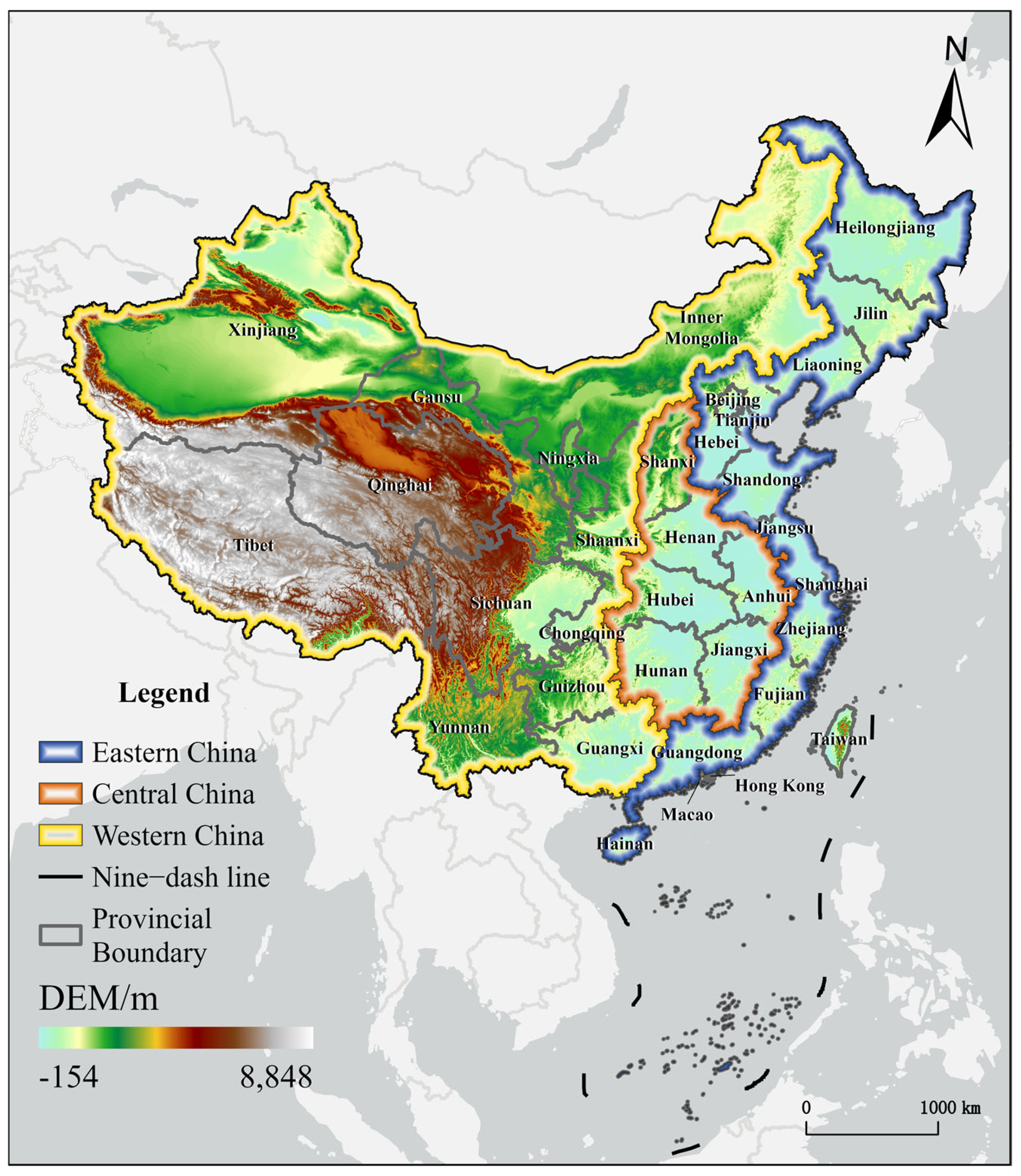
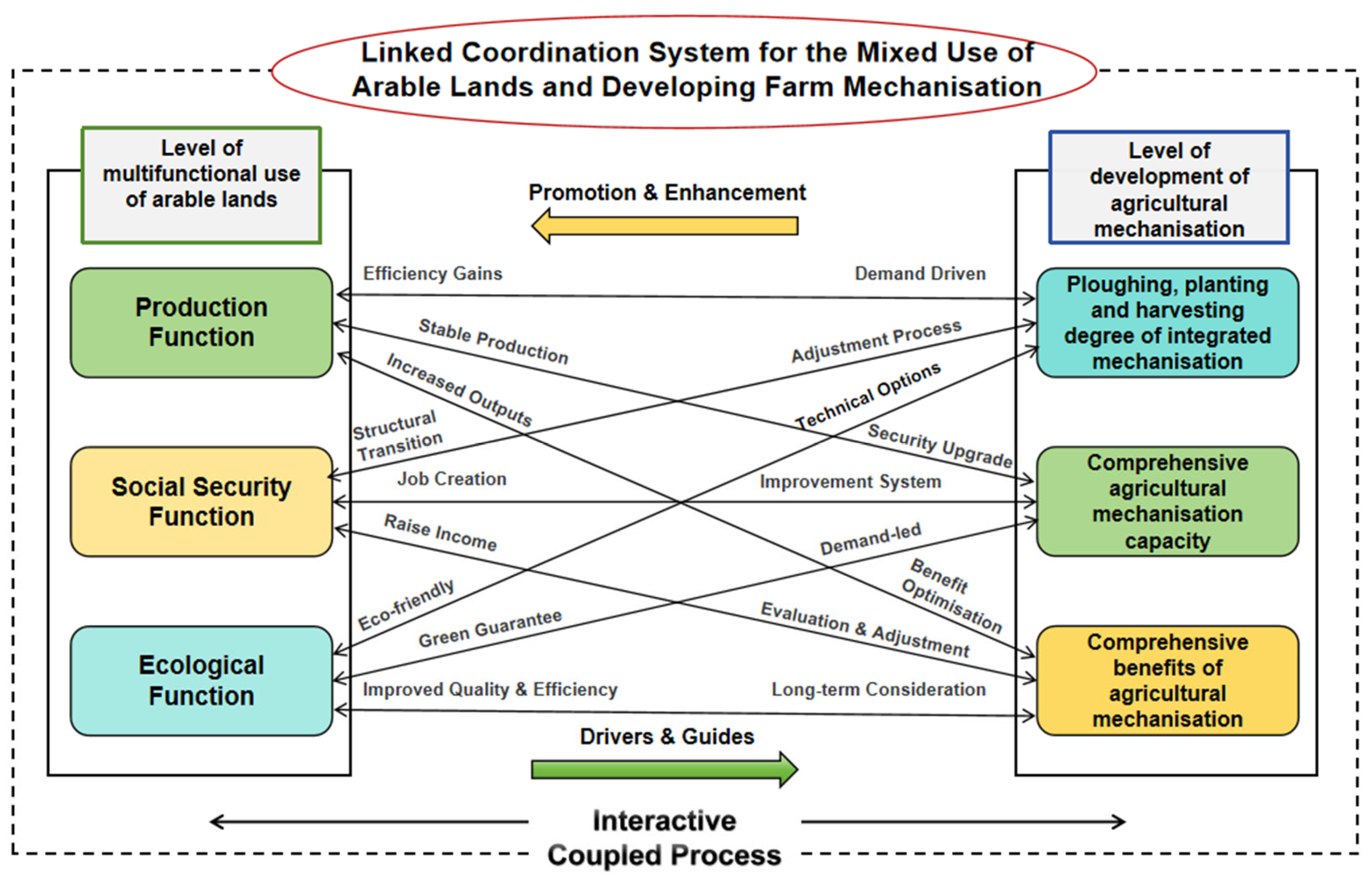


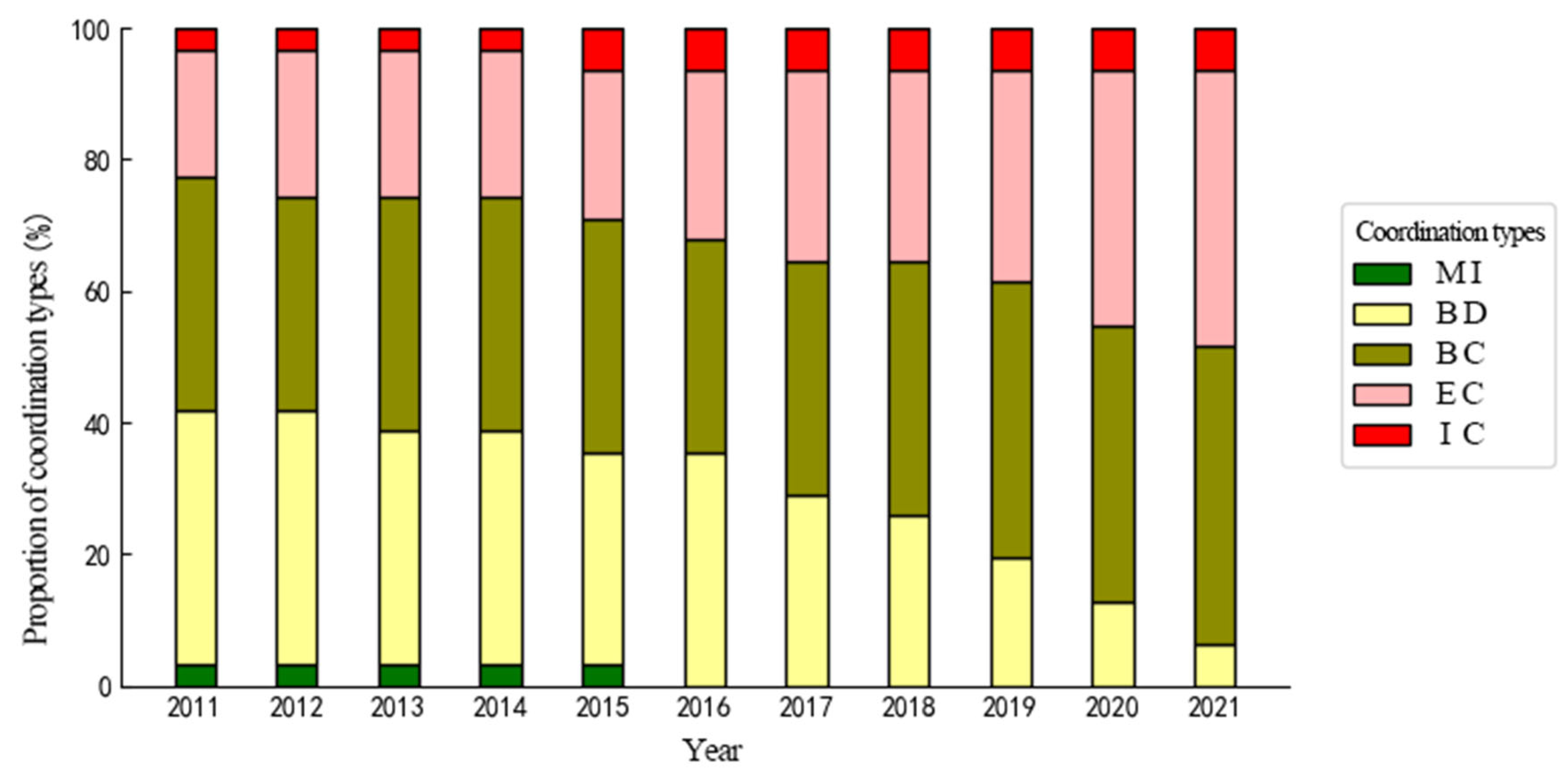
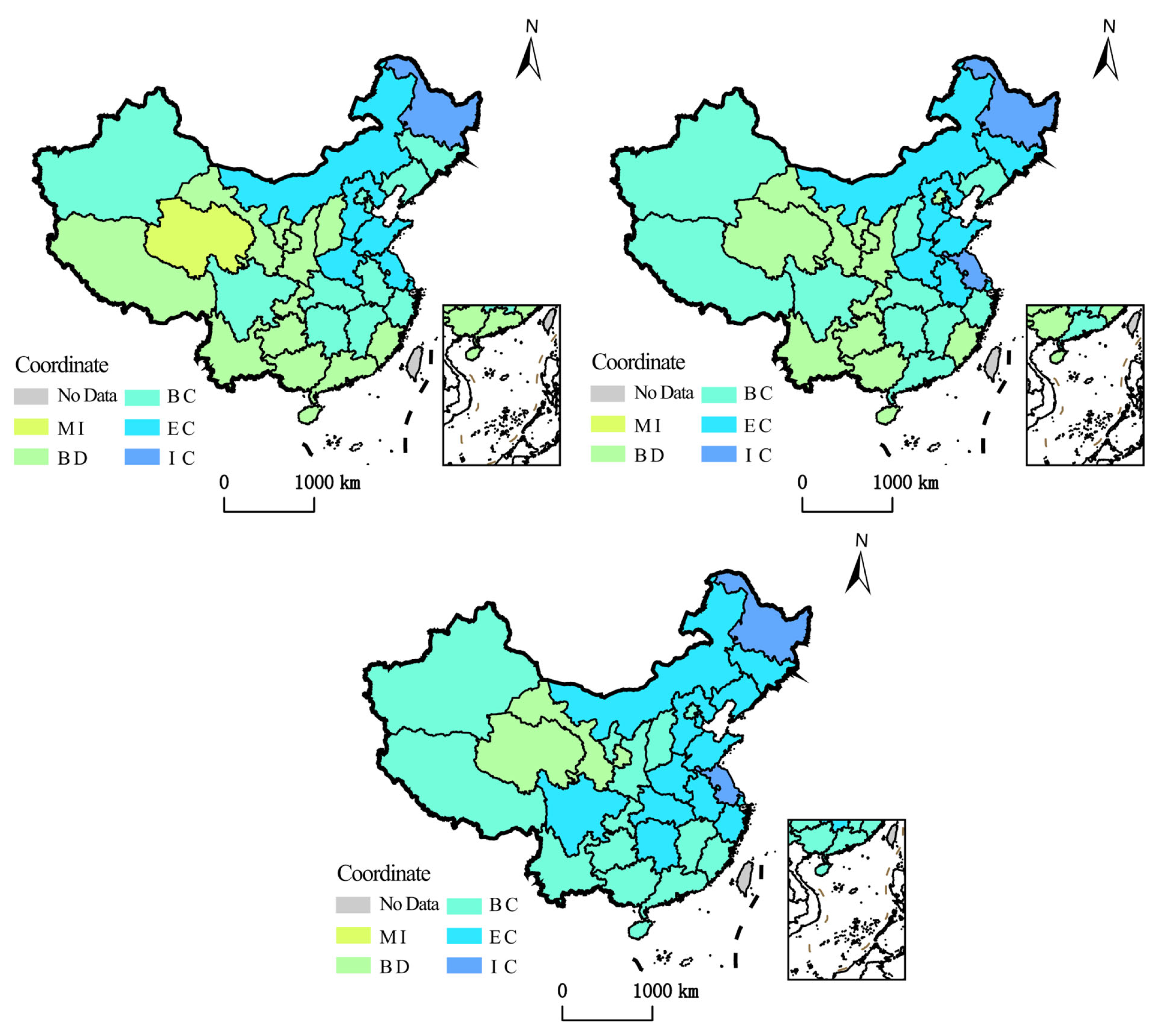
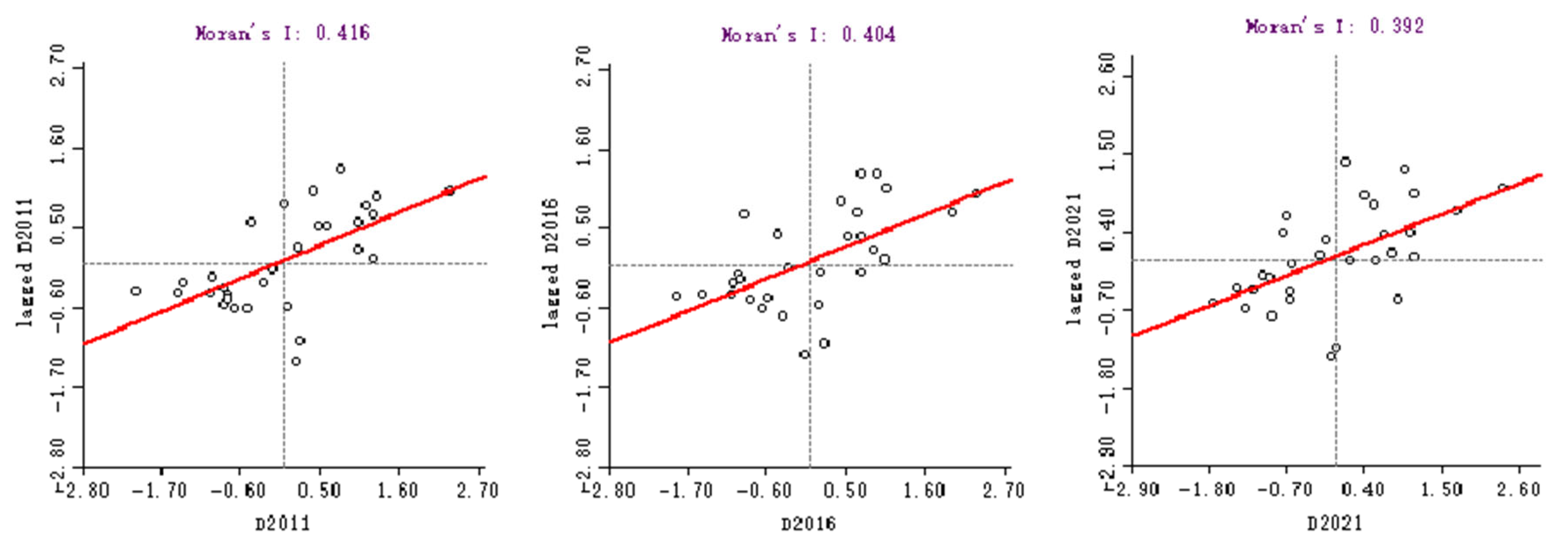
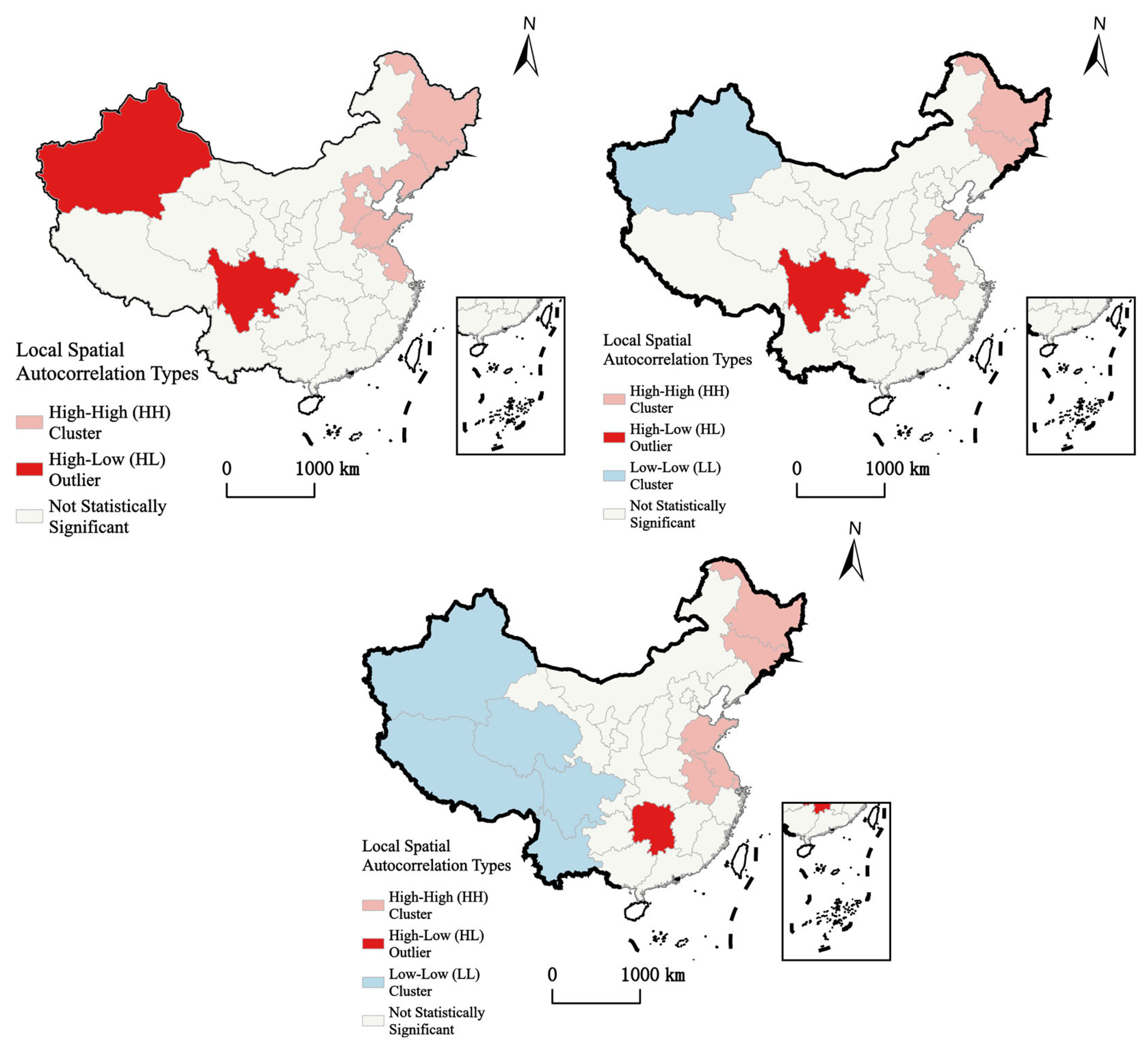
| System Level | Criteria Layer | Weight | Indicator Layer (Units) | Weight | Impact | Indicator Calculation and Data Sources |
|---|---|---|---|---|---|---|
| Level of multi-functional utilisation of arable land | Production functions | 0.25 | Yield of grain sown/(tonnes/ha) | 0.15 | + | Grain sown area/grain production, China Rural Statistics Yearbook |
| Grain output per hectare of arable land/(tonnes/ha) | 0.31 | + | Total grain output/cultivated land area, Agricultural Statistics Yearbook, China Rural Statistics Yearbook | |||
| Land resettlement rate/per cent | 0.34 | + | Arable land/total land area, China Rural Statistics Yearbook | |||
| Recultivation index | 0.21 | + | Sown area/cultivated land, China Rural Statistics Yearbook | |||
| Social security functions | 0.18 | Number of people employed in villages/(10,000 people) | 0.33 | + | China Rural Statistical Yearbook | |
| Per capita net income of farmers/(yuan) | 0.18 | + | China Rural Statistical Yearbook | |||
| Per capita operating area of arable land/(ha) | 0.34 | + | Arable land/agricultural population, China Rural Statistical Yearbook | |||
| Urban–rural income ratio | 0.14 | − | Per capita disposable income of urban residents/per capita net income of farmers, Statistical Yearbook and Urban Statistical Yearbook | |||
| Ecological function | 0.57 | Carbon emission/(tonnes) | 0.20 | − | Fertiliser use × 0.89 + Plastic film use × 5.18 + Agricultural diesel use × 0.59 + Pesticide use × 4.93 + Crop sown area × 312.6 + Irrigated area × 266.48 [36], China Rural Statistical Yearbook, China Environmental Statistical Yearbook | |
| Ecological service value of arable land | 0.80 | + | Ecosystem service value assessment method, using CLCD [37] as the base map to calculate the total ecological service value of arable land in each region | |||
| Level of agricultural mechanisation | Water for integrated mechanisation of cultivation, planting and harvesting | 0.18 | Degree of mechanisation of ploughing/(%) | 0.4 | + | Machine ploughing area/cultivable land, China Rural Statistical Yearbook, China Agricultural Machinery Statistical Yearbook |
| Mechanisation of sowing/(%) | 0.3 | + | Machine sown area/total sown area of crops, China Rural Statistics Yearbook, China Agricultural Machinery Statistics Yearbook | |||
| Degree of harvesting mechanisation/% | 0.3 | + | Machine harvested area/total harvested area, China Rural Statistics Yearbook, China Agricultural Machinery Statistics Yearbook | |||
| Comprehensive agricultural mechanisation capacity | 0.53 | Agricultural diesel use per agricultural labourer/(t/person) | 0.3 | + | Agricultural diesel usage/number of agricultural labour force, China Rural Statistical Yearbook, China Agricultural Machinery Statistical Yearbook | |
| Agricultural machinery power per unit sown area/(kW/ha) | 0.3 | + | Total power of agricultural machinery/total sown area of crops, China Rural Statistical Yearbook, China Agricultural Machinery Statistical Yearbook | |||
| Proportion of professionally trained farm machinery personnel/% | 0.4 | + | Professionally trained rural agricultural machinery personnel/total rural agricultural machinery personnel, China Agricultural Machinery Statistical Yearbook | |||
| Comprehensive benefits of agricultural mechanisation | 0.29 | Agricultural labour productivity/(yuan/person) | 0.4 | + | Total output value of agriculture, forestry, animal husbandry, and fishery/number of agricultural labourers; China Statistical Yearbook; China Rural Statistical Yearbook | |
| Average sown area of agricultural labour/(ha/person) | 0.3 | + | Total sown area of crops/number of agricultural labour force, China Rural Statistics Yearbook | |||
| Proportion of agricultural labourers in the total number of employed persons in society/% | 0.3 | + | Number of agricultural labour force/number of employees in the whole society, China Statistical Yearbook, China Rural Statistical Yearbook |
| Year | 2011 | 2012 | 2013 | 2014 | 2015 | 2016 | 2017 | 2018 | 2019 | 2020 | 2021 |
|---|---|---|---|---|---|---|---|---|---|---|---|
| National | 0.522 | 0.529 | 0.536 | 0.543 | 0.548 | 0.548 | 0.554 | 0.561 | 0.572 | 0.586 | 0.599 |
| Eastern | 0.560 | 0.568 | 0.578 | 0.582 | 0.586 | 0.586 | 0.594 | 0.602 | 0.615 | 0.626 | 0.638 |
| Central | 0.534 | 0.543 | 0.544 | 0.554 | 0.562 | 0.566 | 0.571 | 0.579 | 0.587 | 0.603 | 0.620 |
| Western | 0.475 | 0.480 | 0.486 | 0.495 | 0.498 | 0.497 | 0.502 | 0.507 | 0.518 | 0.535 | 0.545 |
| Year | 2011 | 2012 | 2013 | 2014 | 2015 | 2016 | 2017 | 2018 | 2019 | 2020 | 2021 |
|---|---|---|---|---|---|---|---|---|---|---|---|
| Moran’s I | 0.415603 | 0.427697 | 0.443086 | 0.409410 | 0.389166 | 0.404494 | 0.422578 | 0.459596 | 0.453015 | 0.429186 | 0.392223 |
| Z-value | 3.832523 | 3.940016 | 4.062639 | 3.781752 | 3.602835 | 3.740986 | 3.897567 | 4.208393 | 4.155160 | 3.943617 | 3.626975 |
| p-value | 0.000127 | 0.000081 | 0.000049 | 0.000156 | 0.000315 | 0.000183 | 0.000097 | 0.000026 | 0.000033 | 0.000080 | 0.000287 |
| National | A (***) | B (***) | C (***) | D (***) | E (*) | F |
|---|---|---|---|---|---|---|
| Standardised correlation coefficient | 0.340 | 0.285 | 0.247 | 0.316 | 0.132 | 0.060 |
| p-value | 0.000 | 0.000 | 0.001 | 0.000 | 0.032 | 0.136 |
| East | A (*) | B (*) | C (*) | D (***) | E | F (*) |
| standardised correlation coefficient | 0.370 | 0.359 | 0.411 | 0.569 | 0.055 | 0.319 |
| p-value | 0.014 | 0.012 | 0.014 | 0.001 | 0.333 | 0.034 |
| Central | A (*) | B (**) | C | D | E | F |
| standardised correlation coefficient | 0.724 | 0.878 | 0.353 | 0.193 | −0.082 | −0.08 |
| p-value | 0.012 | 0.002 | 0.121 | 0.196 | 0.42 | 0.367 |
| West | A | B | C (***) | D | E | F |
| standardised correlation coefficient | 0.213 | 0.366 | 0.726 | 0.122 | −0.227 | 0.263 |
| p-value | 0.192 | 0.077 | 0.001 | 0.224 | 0.056 | 0.129 |
| Potential Factors | Characterisation Indicators | Abbreviations | Indicator Calculation and Data Sources |
|---|---|---|---|
| Natural environmental factors | Arable land quality | FQ | , i is arable land quality grade; is the proportion of arable land in each quality grade, estimated from the national bulletin on arable land quality grades issued [67] |
| Arable land area | FA | China Statistical Yearbook | |
| Land flatness | LF | Average slope of arable land in each province of China based on DEM calculation [75,76,77] | |
| Fragmentation of arable land | FF | Extracted from the 2020 China 1 km grid cropland fragmentation dataset [78] | |
| Average annual precipitation | AAP | China Climate Bulletin | |
| Economic development factors | Gross regional product | GDP | China Statistical Yearbook |
| Per capita net income of farmers | PCI | China Rural Statistics Yearbook | |
| Social factors | Number of people employed in primary industry | EPI | China Statistical Yearbook |
| Urbanisation level | UL | Urban resident population/resident population, China Statistical Yearbook | |
| Informatisation conditions | Software business income | DF | China Statistical Yearbook, NBS and provincial statistical yearbooks |
| Agricultural basic conditions | Agricultural loans | AL | Rural Financial Services Report of China, all years |
| Transport network density | TND | (railway mileage + road mileage)/area of administrative division, National Bureau of Statistics | |
| Number of farmers’ specialised co-operative societies per 10,000 people in rural areas | CC | China Rural Statistical Yearbook | |
| Average years of education of rural residents | AY | China Rural Statistical Yearbook |
| Mark | FQ (*) | FA (***) | LF (*) | FF | AAP | GDP | PCI |
|---|---|---|---|---|---|---|---|
| Standardised correlation coefficient | 0.349 | 0.437 | 0.282 | 0.038 | −0.033 | 0.171 | 0.058 |
| p-value | 0.020 | 0.000 | 0.020 | 0.266 | 0.324 | 0.069 | 0.240 |
| Mark | EPI | UL | DF | AL | TND | CC (*) | AY |
| standardised correlation coefficient | −0.05 | −0.067 | 0.028 | 0.187 | 0.098 | 0.181 | 0.019 |
| p-value | 0.250 | 0.267 | 0.331 | 0.063 | 0.105 | 0.040 | 0.323 |
Disclaimer/Publisher’s Note: The statements, opinions and data contained in all publications are solely those of the individual author(s) and contributor(s) and not of MDPI and/or the editor(s). MDPI and/or the editor(s) disclaim responsibility for any injury to people or property resulting from any ideas, methods, instructions or products referred to in the content. |
© 2025 by the authors. Licensee MDPI, Basel, Switzerland. This article is an open access article distributed under the terms and conditions of the Creative Commons Attribution (CC BY) license (https://creativecommons.org/licenses/by/4.0/).
Share and Cite
Qin, Y.; Li, Z.; Huang, E.; Lu, D.; Fang, S.; Duan, X.; Gao, L.; Zhao, Y.; Kang, H.; Liu, Z.; et al. Analysis of Coupled and Coordinated Development of Cultivated Land Multifunction and Agricultural Mechanization in China. Land 2025, 14, 999. https://doi.org/10.3390/land14050999
Qin Y, Li Z, Huang E, Lu D, Fang S, Duan X, Gao L, Zhao Y, Kang H, Liu Z, et al. Analysis of Coupled and Coordinated Development of Cultivated Land Multifunction and Agricultural Mechanization in China. Land. 2025; 14(5):999. https://doi.org/10.3390/land14050999
Chicago/Turabian StyleQin, Yuan, Zhongbo Li, Enwei Huang, Dale Lu, Shiming Fang, Xin Duan, Lulu Gao, Yinuo Zhao, Hanzhe Kang, Zixuan Liu, and et al. 2025. "Analysis of Coupled and Coordinated Development of Cultivated Land Multifunction and Agricultural Mechanization in China" Land 14, no. 5: 999. https://doi.org/10.3390/land14050999
APA StyleQin, Y., Li, Z., Huang, E., Lu, D., Fang, S., Duan, X., Gao, L., Zhao, Y., Kang, H., Liu, Z., & Yang, Z. (2025). Analysis of Coupled and Coordinated Development of Cultivated Land Multifunction and Agricultural Mechanization in China. Land, 14(5), 999. https://doi.org/10.3390/land14050999





